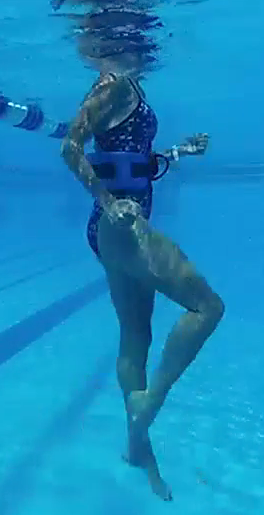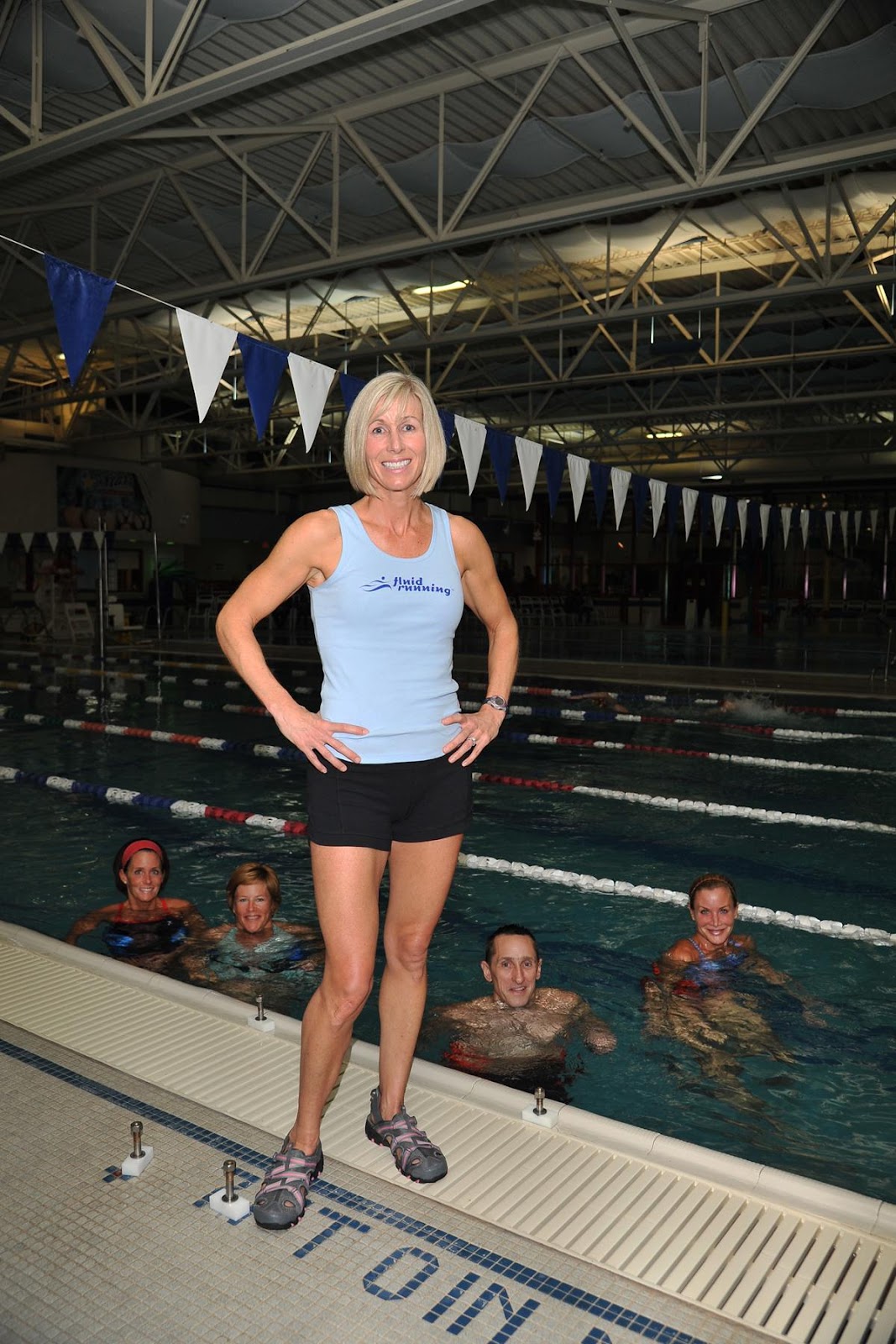Running to new depths:
A Fluid Running Feature
June 2015

Summer is finally here and everyone is looking forward to hoping in the pool for a “cool-down!” However, over at Fluid Running, athletes are jumping in the pool for a great warm-up, lots of sweating and injury recovery through deep water running. It is easy to be skeptical about this type of workout as most people have only ran on “dry-land” and stuck to swimming when introduced to the water. Jennifer Conroyd, founder of Fluid Running, is out to dispel the myths of leisurely “water aerobics” and deliver a high intensity, low impact workout to anyone interested including athletes, teenagers, seniors and those struggling with their weight.
Deep water running sounded interesting to some of the staff at Achieve so a few months ago they volunteered to meet Jennifer with Fluid Running and try it for themselves. Between a professional tri-athlete, former level 10 gymnast and a short distance runner, the expectation was that it would be a breeze. False! The words “tough” and “super hard” only begin to describe the experience. Nothing could have prepared our staff for this workout, except maybe a few beginner courses at Fluid Running.
Running in the water requires optimal core engagement, upper body stabilizers, and cardiovascular conditioning. Workouts result in 30-40% more burned calories than running on land. Caroline Yasuda, a Fluid Running instructor, is an avid runner and works at Naperville Running Company. She works with all levels of runners and refers to deep water running as “a positive way to improve your running, strengthen your core and have fun too.” Even in her own experience, Caroline has used Fluid Running as a way to still get her workout in but less impact than the outdoors.


Our staff may have had a tough time getting through a deep water running workout but classes are customizable to individual abilities and the benefits are undeniable. Participants do not even need to know how to swim! These workouts offer a minimal-impact alternative to dry land workouts that is perfect for individuals that have an injury, suffer from joint pain when trying to be active or need an alternative to their normal training regimen. The water pressure combined with the movement of the legs aids in removal of metabolic waste that typically causes muscle soreness and inflammation. Joints are “off-loaded” and muscles receive 30% more blood flow, which is essential for recovery. In fact, a sidelining injury is exactly how Jennifer first discovered deep water running.
We were curious to find out exactly how Jennifer went from dry-land running to founding Fluid Running and luckily she was willing to share her story with us:
Tell us how you got started with Fluid Running.
I was training for the Chicago Marathon in 2010. My family of 5 siblings had created a fundraising team called “10-10-10 for Ben”. We were raising funds for Juvenile Diabetes Research Foundation is support of my young nephew who was diagnosed with Diabetes. We raised over $10,000. About 6 weeks before the marathon, I tore my calf muscle on a run and believed in that instant that I was out of the race. My doctor told me I couldn’t run and needed to let it heal. Determined to run the marathon, I began researching alternative training options and came upon deep water running. I found an article on deep water running written by Kevin Beck, an elite runner and author of the book Run Strong. The article provided a 9-week plan to recover and stay in running shape with deep water running. I emailed him and asked if he could help me make it to my marathon. He agreed and coached me for the next month or so. All I did was deep water run for over a month leading up to the marathon. As a personal trainer and a coach of amateur athletes, I said to myself “if this works and you can not only stay in running shape but marathon running shape in the water…this is what I’m going to do with the rest of my life.” Well, I finished that marathon not far off my best time. I called Kevin after to ask how I could become certified to coach deep water running. He said there were no certifications in the United States and that I’d have to go to Australia or Canada. Canada was closer, so off I went. I came back and created Fluid Running. We now have group classes, private coaching and an instructor certification program.
Who can participate in Fluid Running? Elite athletes? Obese? Adolescents?
Just about anybody can participate in Fluid Running. We have the full spectrum in our classes from runners to people struggling with their weight, to teenagers and seniors. We recently started a senior class at the Oak Brook Park District and it’s very successful. They love it! We are currently working on a class specifically designed for the obese population. Among the many benefits of deep water running is the ability to get a really great workout without joint impact. Obese people have even more stress on their joints due to the extra weight. Deep water running burns about 30-40% more calories than running on land. We also work with elite runners and a lot of state qualifying high school athletes. They seem to prefer private sessions rather than group classes. I personally have worked with all ages and do find that kids under the age of 10 have a tough time holding proper form. It takes good body awareness and an ability to engage the core to deep water run properly. Younger kids seem to have a tougher time with that.
You and Gina have known each other for 10+ years, talk to us about how your businesses have been able to work together for the greater good of the patient/client.
Well, to be honest, Gina sends me more patients than I send her! She is responsible for a big percentage of my private clients. Most people come to me after they have seen a doctor, have started physical therapy and are told they can’t run or bike. Gina has told me that she likes being able to tell her patients that yes, they can still get their workout in…just not on land. It’s great because while they are being treated for their injury with Achieve, they are able to stay in peak physical condition with Fluid Running. It’s great for anyone recovering from an injury or surgery. Doctors and physical therapists usually want you moving. Fluid Running allows that.
Can Fluid Running be a good cross-training exercise for athletes looking to “switch it up?”
Yes, but I’d like to clarify that deep water running, done properly, can be so much more than just cross training. Athletes can replicate just about any land training run in the water – long run, tempo run or track run. Done with the proper intensity and matching their land-based training heart rates, athletes can count deep water running as their RUN. We work with high school athletes and when we do heart rate checks after a track set, they’re at 200 bpms! This isn’t a “stretch it out, take it easy” kind of a workout. It can be, and can also be great cross-training, but I’m trying very hard with Fluid Running to dispel the myth that deep water running is an easy, nice alternative for athletes.
What should athletes (or people) know about the benefits of deep water running?
I always tell people that with deep water running, “you get all the benefits of land running, and more!” As I mentioned, done with the proper intensity, athletes can realize all the benefits of land running – both muscular and cardiovascular. The “and more” part is what’s so great about it. For example, in order to stay in the upright position while deep water running, the core needs to be engaged the entire time. All upper body stabilizers are firing to keep the body upright. This results in a stronger upper body and therefore better land running form. While running on land does not build arm muscle strength, running in water does! Water is 800 times denser than air and the pendulum/swinging arm motion builds strength. The hydrostatic pressure (water pressure) on the body, particularly the lower half of the body, has tremendous benefits. In combination with the movement of the legs, the moving water pressure helps to flush out any metabolic waste, like lactic acid and can reduce swelling from injuries. I tell people it’s an oxymoron…you can do the hardest “track workout” of your week and come out feeling like you had a massage…because you kind of did. I call it a “hydro-massage”!
Visit www.fluidrunning.com for more information!